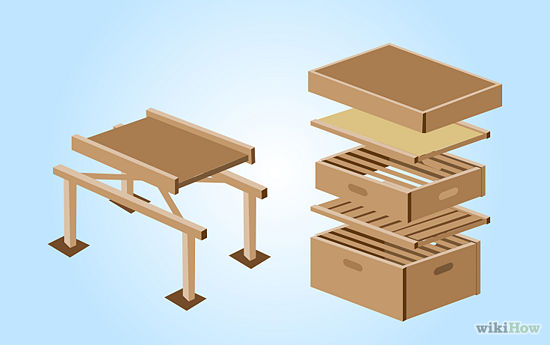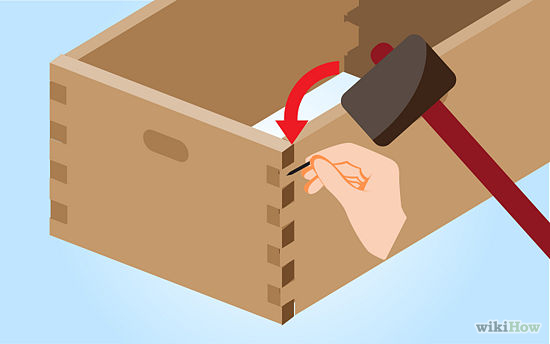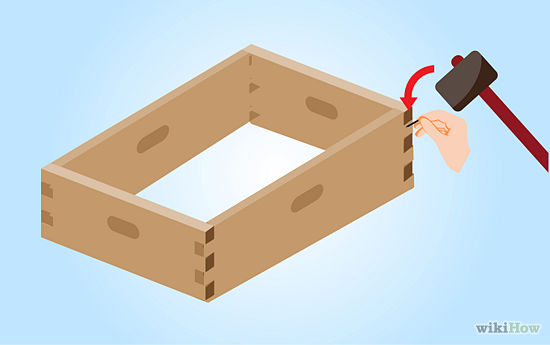People who have gardens and appreciate the importance of bees in the natural environment may seek to keep bees of their own. Bee boxes, or hives, today are designed to encourage the health of the bee society as well as make it easy for the beekeeper to remove the honey from the hive with the least disruption possible. A honey bee box is made up of a hive stand, bottom board, hive bodies (brooder), smaller boxes called honey supers, and a cover. The lower hive body is separated from the supers above by an excluder. Learn how to make a honey bee box to begin the beekeeping process.
Edit Steps
- 1Purchase the wooden ware for your hive bodies from a reputable bee supplier. You will need at least 1 brooder and 1 super to start. You will also need a cover, excluder, baseboard, and a hive stand.
- Order the frames to fit both the brooder and the super as the frames for the brooder will be larger. The brooder will need 9 frames and the super 8 frames.
- 2Lay out the parts for the brooder. There will be 2 short sides that are 16.25-by-9.56 inches (41.28-by-24.28 cm) and 2 long sides that are 20-by-9.56 inches (50.8-by-24.28 cm). All 4 sides will have tongue and grove or dovetailed ends.
- 3Lay a thin bead of all-weather wood glue along the edges that will go together.
- 4Assemble a bee box. Press the sides of the box together to form a rectangle, and fit the dovetailed ends so that they interlock.
- 5Use a hammer to fasten the sides together with nails in the pre-drilled nail holes. You will need 10 nails for each corner of the brooder.
- The nails must be bought separately.
- 6Assemble the super, which is 20-by-16.25-by-6.63 inches (50.8-by-41.28-by-16.83 cm), the same way. Use 8 nails for each corner.
- 7Cover an area with newspapers or plastic, and paint the outside of the hive bodies with white outdoor paint.
- Do not paint the inside of the box.
- 8Buy or build your own baseboard at home that creates the correct size bee entry. It needs to be .75 inches (1.91 cm) for summer entrance and .38 inches (.95 cm) for winter entrance. Entrances that are larger may encourage an infestation of rodents.
- Some commercially bought bases are reversible for the correct seasonal entrance. This reduces the cost of the setup as well as circumventing the need for the storage of 1 base during the off-season.
- Use white paint on the exposed areas of the baseboard.
- 9Buy an excluder for your bee box. This fits on the top inside of the brooder and prevents the queen from moving into the supers.
- 10Buy or make a cover for your beehive. The cover should telescope out over the sides of the hive bodies and fit snugly. Many covers are topped with a thin sheet of metal to protect it from weather.
- 11Assemble a beehive. Place frames in the notched metal bars on the brooder and super. Then place the baseboard on a hive stand, followed by the brooder, then the excluder, and a super. Top with a cover.
- The hive stand can keeps the beehive up off the ground to help keep the bottom dry and to insulate the hive. The hive stand can be made of anything that holds the hive up, or you can use a commercially purchased one.
Edit Tips
- Bees are very precise insects, so you when you make a beehive, ensure that the measurements are accurate. Hives with too much room can encourage bees to build burr comb between spaces. Too little room causes the bees to leave.
Edit Things You'll Need
- Wooden ware for hive bodies
- All-weather wood glue
- Hammer and nails
- Newspapers or plastic
- White paint and paintbrush
- Baseboard
- Cover
- Hive stand
Edit Related wikiHows
Edit Sources and Citations
- http://www.scottishbeekeepers.org.uk/learning/documents/number%205%20langstroth%20and%20md%20hive.pdf
- https://www.dadant.com/catalog/product_info.php?cPath=90&products_id=938
- http://www.dadant.com/journal/faq.html
- http://www.dadant.com/journal/components.html
- http://www.bee-commerce.com/content/freedownloads/DeepHiveBody.pdf
Article Info
Categories: Woodworking | Bugs
Recent edits by: VermontGal, Denise, Tiagoroth



















